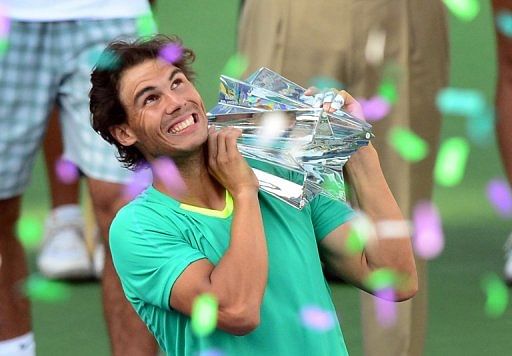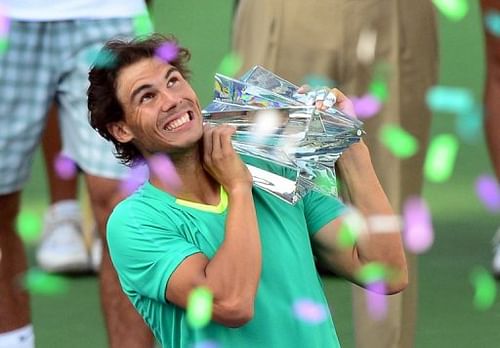
Resurgent Nadal sets sights on clay-court season
INDIAN WELLS, California (AFP) –

Rafael Nadal of Spain holds the championship trophy after defeating Juan Martin Del Potro of Argentina in three-sets on March 17, 2013 in Indian Wells, California, in the men’s tennis final at the BNP Paribas Open.
Rafael Nadal appears poised to reign again on the clay courts of Europe, now that his balky knee has stood the test of the world’s best on the punishing hard courts of Indian Wells.
The fearsome forehand, the quickness, the sheer grit that have long characterised his game were all on display on Sunday as Nadal rallied from a set and a break down to beat Juan Martin del Potro for the Indian Wells Masters crown — his biggest triumph since returning from a seven-month absence resting and rehabilitating his damaged left knee.
By the time his Indian Wells run was done, Nadal had answered all the questions — most importantly his own — as to how his knee would hold up and where his game would be.
“Seriously,” he said, “it’s impossible to have better comeback, no?”
Strictly speaking, the comeback appears to be complete. With a 17-1 match record Nadal is actually off to the best start to a season in his career.
He contested four finals in four events and won three titles. True, he wasn’t slugging it out with the world’s best at the Australian Open in January, but he called his 6-0, 6-2 destruction of compatriot David Ferrer in the final at Acapulco one of the best clay-court matches he’s ever played.
“He’s going to be fighting for the first position very soon,” del Potro predicted.
With his victory at Indian Wells, Nadal has already made a key jump in the rankings, supplanting Ferrer at No. 4.
That puts him numerically back in line with his companions in the “big four” of men’s tennis — Novak Djokovic, Roger Federer and Andy Murray.
Most importantly it will spare him the kind of quarter-final match-up he ran into in Indian Wells, when his fifth seeding saw him drawn in the same quarter as defending champion Federer.
Not that Nadal had any trouble dispatching the Swiss great, just as he had taken care of red-hot Latvian Ernests Gulbis and as he would handle sixth-ranked Czech Tomas Berdych.
With his first hard-court title since 2010 safely secured, Nadal turned his attention to the European clay-court season, opting out of the Miami Masters on doctors’ advice.
He needs to rest his knee, for which he still takes anti-inflammatories before his matches, and he needs to devote time to rehab work to strengthen his left quadriceps to prevent further injury.
He plans to play next in Monte Carlo in April, with Barcelona, Madrid and Rome pencilled in before the French Open — where he has won seven of his 11 Grand Slam titles.
Nadal has dominated that red clay route like no-one else over the last eight years, but insists he goes into every season aiming to prove himself again.
“For me, clay doesn’t mean victory,” he said. “This is the surface that I love to play and I had great success in the past, but every year is a different year.
“Every year I have to improve. So I’m going to go to Monte Carlo with the same expectations as ever, and I’m going to try my best to arrive there healthy and in good shape playing well.”
Del Potro, whose own Grand Slam breakthrough at the 2009 US Open was followed by a 2010 season shortened by a serious wrist injury, said Nadal’s ability to return from his extended absence so quickly on every level was remarkable.
“It’s very difficult,” he said. “First you have to lose the fear about your problem, and then take matches to feel good.”
Del Potro was deeply impressed by the speed with which Nadal progressed, from his first tournament back at Vina del Mar to Indian Wells.
“It’s amazing how fast he has recovered the level,” del Potro said.
When del Potro’s final shot floated wide on match point on Sunday, Nadal slid to his back, shouting at the blue California sky.
“When you have one comeback like I’m having, you remember all the low things, lower moments that you had during this seven months, doubts and all these things,” Nadal said. “Hopefully I’m past that.”